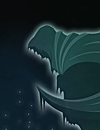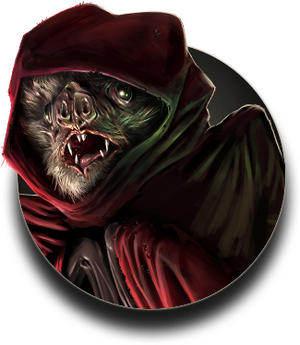Curators

|
WARNING: Beyond this point lie extended spoilers for Fallen London, Sunless Sea, Sunless Skies, or Mask of the Rose. This may include endgame or Fate-locked content, including spoilers for formerly restricted storylines such as the endings of Seeking Mr Eaten's Name. Look away now. You can find out more about our spoiler policy here. |
"Intelligent, locomotive-sized chiroptera, able to pry an engine apart with their claws, or pummel it with their hellish shrieks. Curators accumulate hoards, which they guard violently. Each hoard collects artefacts or creatures themed to the Curator’s particular obsession."[1]
Curators are a chiropteran species native to the High Wilderness. Or, to put it simply: space bats.
An Anatomy Lesson
"The Masters wouldn't care for you saying so. But the wings, the arms and legs, all fit."[2]
Curators are bat-like bipeds that possess both arms and wings;[3][4] their fingers are clawed,[5] and their hind talons allow them to hang upside down as a bat would.[6] Some Curators are also known to possess horns,[7] or even semi-sentient teeth which can move independently from their owner.[8][9] In their natural environment, Curators are massive (described as "locomotive-sized"),[10] but they can shrink to two or three meters tall to interact more properly with humans[11] — an ability that may falter when they become enraged.[12][13]
Though extremely long-lived and incredibly difficult for a human to kill,[14] Curators are far from unkillable broadly speaking. Rather, the most effective methods of doing so are rare, esoteric, and either mind-bogglingly expensive or inaccessible to a species so low on the Great Chain of Being. Curators are immune to most toxins, even including Cantigaster venom;[15] their hide is bulletproof,[16] and the firepower required to damage it is tantamount to a weapon of mass destruction.[17] They are, however, sensitive to sound (as bats are),[citation needed] and at least one of the Masters of the Bazaar is known to enter a state of intoxication when exposed to music.[18][19]
Curators rely on their claws, speed, and physical ferocity in combat, but they can also bombard their enemies with ear-splitting shrieks[10][20] and invocations of the Correspondence.[21] Since the Correspondence is their native language,[22] battles between Curators may be akin to a very heated debate[23] — and a debate conducted in the language of the stars has legally binding outcomes.[24]
Curators may hybridize with other species, but the extent to which this is possible is uncertain.[25] Childbirth among Curators takes place while the parent is hanging upside down,[26] in a physically and mentally taxing process[27] that must align with the newborn's obsession.[28] While information about infant Curators is scant, the sole known example was the size of a human baby, with similar features like a large head and eyes;[4] however, it was fully active and capable of interacting with its environment from the moment of birth.[29] Despite the intensive demand of Curator reproduction, familial bonds among this species appear to be weak or fleeting, and emotional attachment between parent and child is minimal at best.[30]
Runtery
"A Tree which lacks the Dual Nature is less. A Beast which lacks the Dual Nature is no less. This kind are not Trees, nor are they Beasts. Each Clutch has sometimes its Runt, who lacketh part of the Nature. Even the Runt has uses. Consider the Owl."[31]
A final trait unique to Curators is something called the Dual Nature, the precise meaning of which is unclear. "Beasts" are not diminished by the lack of the Dual Nature, but "Trees" and Curators are.[32] Sometimes a clutch (litter) of Curators includes one that lacks a part of the Dual Nature, called a Runt.[32] Runts are preyed upon by other Curators,[32] who view them as weak,[33] and even the very notion of "runtery" is a crime in Curator society.[34] While it may be the case that Curator runts are physically smaller than their siblings,[35] a Curator's status as a runt does not appear to have any connection with gender or assigned sex: while Mr Candles uses he/him pronouns,[36] Mr Menagerie uses it/its pronouns like other Curators.[33] According to Mr Pages, elderly Curators are more likely to bear only one child rather than a litter, and if a Curator only has one baby, that baby will be a Runt.[37] It is possible that Mr Candles was not the only Runt among the Masters, but the only source for this assertion is unreliable.[38]
Cosmic Hoarders
"Once, we gathered here. We held our bargains and boasted of our chiefs. Our bands displayed the finest of goods. Our magnanimity was sharp as knives. All knew our worth. Then the light came. They made of our grounds sport. A dancing place. A laughing place. They made bargains of their own."[39]

Every Curator is born with an innate obsession, an overpowering urge to acquire and hoard a specific object or concept.[40] This obsession is present even before birth; in fact, an expecting parent Curator can experience its child's obsession as a unique form of pregnancy cravings.[41] Curators store objects they hoard inside large, sticky, papery globes, which human explorers call "Curator's Eggs."[42] When on the move, they use a net harness to carry their treasures with them.[43]
Curators spend much of their time alone or in small groups called flocks,[44] traveling and hunting in the High Wilderness. Occasionally they congregate in large numbers to trade and socialize;[45] during these gatherings, they follow a strict calendar called the Order of Days that determines their activities.[46] Wealthy, successful Curators become band leaders and magnates amongst their comrades.[45][47] It is unclear how much control the Curators hold over the skies, but some quantity of their old hunting grounds has been conquered by the Judgements.[45]
Below are the known observances of the Order of Days:
- The Day of the Hunt, ordained for the hunting of lesser creatures, showing off trophies,[48][49] and dueling to settle past grievances.[50] Curators customarily set aside language and socialization until the end of the day.[50]
- The Day of the Feast, a time to dine.[51]
- The Day of Council, for discussions and debates.[52]
- The Day of Bargain, when Curators trade.[53]
- The Day of Slaughter, when murder between Curators is permitted.[54]
- The Day of Terminations, a celebration of things that end: "labours, loves, lives."[55]
- An unnamed day for procreation.[56]
Outcasts
"Charity is a crime. The punishment severe."[39]
Curator society is harsh, and a variety of actions and situations may result in ostracism of an individual.[57] Outcast Curators sometimes enter into servitude to Messengers, for protection and a chance to escape their previous misfortune.[58][59] One such group can be found serving the Echo Bazaar in the Neath.[58] A different flock once served the House of Rods and Chains, although they have been disbanded since its death.[60]
Several transgressions against Curator law have been named:
- Hoarding
- Light-bringing
- "Impersonation, and the delivery of false testimony"
- "Perpetration of the crimes of knife and of candle"
- "Idleness, and the dwelling-on of dreams"
- "Runtery, aberration"
- Pursuit of a Treachery
- "Failure and defeat; a fall from king to beggar"
- Glass-whispering
- Charity[61]
- Truth-strangling
- "Violation of the Order of Days, 'which determines the hour of the hunt, the feast, the council, the bargain, and the slaughter'"
Cultural Inspirations
The Curators' defining trait is a biological imperative to hoard something specific, which governs their behavior even before birth. Their collections are not solely for survival or aesthetic pleasure, but a metaphysical need tied to their very existence; they are also conspicuously displayed, with wild Curators even wearing their hoards on their bodies. A Curator's status is directly correlated to the grandeur of their hoard and the intensity of their singular pursuit. It is possible that this is an exaggerated metaphor for capitalist consumer culture, reflecting the societal dynamic of late-stage capitalism in which identity and status are linked to consumption and ownership.
Curators are emotionally detached from their peers and even their own offspring, and profoundly societally alienated. Their only community interaction occurs under rigid, scheduled observances, and they are so engrossed by obsession and accumulation that all other aspects of social life, even reproduction, are hollow and ritualized. Charity, daydreaming ("the dwelling-on of dreams"), and idleness are all crimes in Curator society, essentially disallowing emotional and imaginative aspects of community. In a word, interaction between Curators, no matter the purpose, is entirely transactional.
While the above points serve as potential literary critiques of capitalism, Curators also push the philosophy of Objectivism (as conceptualized by Ayn Rand) to a logical and grotesque extreme. According to Objectivism, rational self-interest is the highest moral purpose, and that productive achievement is the noblest activity of humans; while individuals should pursue their passions (or obsessions) without guilt, altruism is seen as a moral error. Curators, however, are defined by their individual obsessions and ruthless pursuit of their personal truth. Their passion is no longer liberating but imprisoning, and their rejection of altruism leads to isolation rather than freedom. Ironically, while Ayn Rand celebrated self-created value and personal purpose, Curators are born with their obsessions predetermined, rendering them slaves to their own "destinies."
References
|